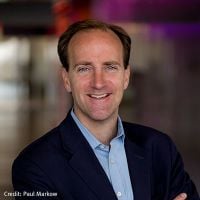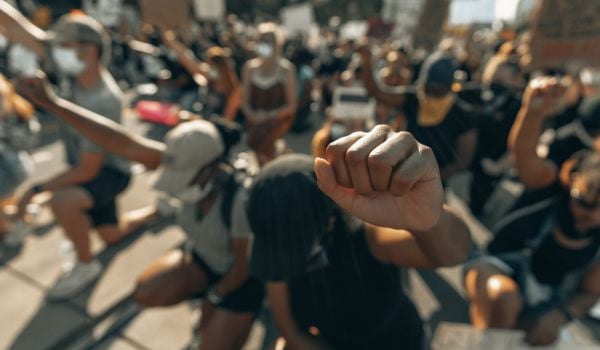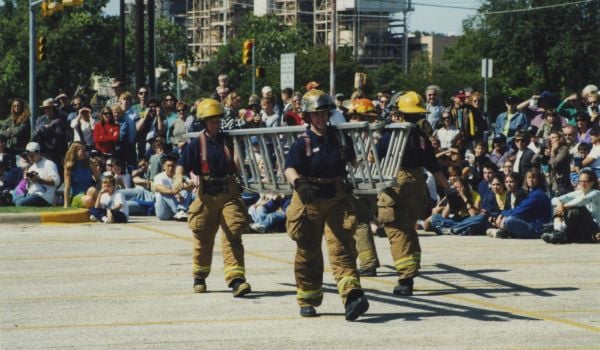This is an adapted excerpt from “City Forward: How Innovation Districts Can Embrace Risk and Strengthen Community” by Matt Enstice with Mike Gluck. Enstice is the president and CEO of the Buffalo Niagara Medical Campus, which is discussed here.
“If you want our money, you’ll have to work together.”
That’s essentially what The John R. Oishei Foundation told three separate anchor institutions when they asked for money to fund new buildings on the Buffalo Niagara Medical Campus (BNMC).
As Buffalo’s largest foundation, Oishei has quietly supported the BNMC from the beginning. But all along, there was one steady condition: The institutions had to collaborate. Funding requests from individual organizations would almost invariably be rejected. Any request had to come from the campus as a whole.
Insisting that the institutions collaborate wasn’t a popular decision. But it was the right one. And the leadership at Oishei knew they could leverage their financial power to make the most of the community’s finite resources.
“It made a lot of sense to take these significant assets and bring them together, because two and two makes five, every time,” says Erland “Erkie” Kailbourne, chairman of the Oishei Foundation, backed by executive director Tom Baker.
By focusing on the good of the entire community, Kailbourne and Baker lived up to the foundation’s namesake, John R. Oishei, who was known for his loyalty to Buffalo. (Oishei invented the first automobile wiper blades and refused to move his company to Detroit despite pressure from Henry Ford himself.)
And it wasn’t just the Oishei Foundation telling us we had to speak with one voice. Bob Kresse, Janet Day, and Tom Lunt at the Margaret L. Wendt Foundation — another early supporter — said the same thing. Even our state legislators basically refused to consider funding requests for one of the anchor institutions unless everyone in the innovation district was on board with the plans.
“People would say to us: ‘Come back to us with a single plan, a single vision, a single ask,’” noted former Buffalo mayor Tony Masiello. “We heard that time in and time out from our Western New York delegation in Albany and certainly from our delegation in Washington.”
Innovation districts and anchor institutions (including foundations) have the opportunity to help shape multiple voices into one cohesive vision, in large part because these organizations are often trusted and well established, with deep roots in the community. They have the resources to span neighborhoods, demographics, and other divides to bring people together, identify the common problems, and find solutions that advance equity.
A Proven Approach
When I was helping develop a plan for the BNMC, my boss, Rick Reinhard, always said our job was to “keep everyone singing out of the same hymnal.” So perhaps it’s fitting that one of our first successes was an alliance with Pastor Michael Chapman.
Pastor Chapman was the leader of St. John Baptist Church, Buffalo’s largest Black congregation. I remember going to meetings in the hallway outside his office, where he set up a table that probably sat 15 or 20 and was often filled to capacity with people from throughout the city, eager to discuss Chapman’s latest plans.
We partnered with Pastor Chapman for a grant from the Robert Wood Johnson Foundation and applied for the grant together. But we knew that there were probably 1,000 applicants vying for a few dozen or so awards. So when the foundation invited us to Baltimore to discuss our application, we happily got on a plane and went (although Pastor Chapman wasn’t quite as excited about it, since he didn’t like to fly). We walked into the room together, shared our vision, and thanked them for their time.
When we were chosen as one of the grant recipients, I asked the foundation what made us stand out. They said it was the fact that Pastor Chapman and the BNMC were true partners every step of the way. He wasn’t just a name on the grant application. Honestly, I don’t think they really believed that a medical campus could have an authentic collaboration with the community, especially one of the city’s lowest-income neighborhoods. But in my mind it was the only way to succeed. Being on the same page was imperative if we wanted to change lives. So we went to the foundation — together — with one request and one common goal. And that made it easy for them to say yes.
A Broad Coalition
In Baton Rouge, a 39-year-old artist with schizophrenia died in jail, reportedly killed by a blood clot induced by the restraints placed on him by jailers. The man’s father, frustrated by a lack of coordinated mental health services throughout the community, started advocating for change.
For the next five years, a variety of partners including local physicians, the police chief, coroner, mental health advocates, and the district attorney all banded together for the cause. These people had diverse professions but shared one goal: secure funding for a facility designed to help people experiencing mental illness and related substance abuse issues.
After a number of setbacks, the funding proposal went to a ballot initiative and passed in a landslide, with nearly seven out of 10 voters approving to fund the Bridge Center for Hope. “I’m just amazed. I never expected that type of support,” says Kathy Kliebert, chairwoman of the Bridge Center, which can help up to five thousand people each year.
Groups that don’t typically work together can often find shared interests when it comes to advancing equity. If you’re trying to garner support for a project, start by casting a broad net. Think about who may agree with your end goal, even if they aren’t one of your typical partners.
Understand Why You Aren’t On The Same Page
If people aren’t speaking with one voice already, think about why not. Are they just accustomed to working in silos? Do they not know about each other’s goals? Or are there more substantial differences you need to overcome? Your strategy and approach should depend on the answer.
When we launched our Farm-to-Hospital program to get more local produce into area hospitals, we helped bring together people whose motivations were different and who didn’t always collaborate but who would all benefit from the project — much like the coalition from Baton Rouge.
Healthcare professionals wanted patients to eat more nutritious food. Local farmers wanted to sell more of their crops. Hospital administrators and purchasing staff wanted to serve fresher food and lower their costs. They weren’t opposed to working together; they just didn’t know that they could. So, as an innovation district, we showed the farmers, healthcare professionals, and administrators that ultimately they all wanted the same thing — more local produce and dairy in hospitals — then got them to agree on a marketing campaign to promote the Farm-to-Hospital initiative.
In some cases, however, there’s real opposition to speaking with one voice. Organizations may be wary of partnering with others, especially if they have a culture of noncollaboration or you’re asking them to share a stage (and the spotlight) with their competitors.
When we tried to get local institutions to combine their funding requests into one ask, we faced a fair amount of pushback. It took the threat of losing funding for them to agree, at least at first.
You may also find that different groups have different problems they’re trying to solve, which makes them resistant to collaboration. In the case of Boston’s Muddy River daylighting project, the Army Corps of Engineers was tasked with improving flooding in a cost-efficient manner, while parks advocates wanted to see the riverbanks replanted to match landscape architect Frederick Law Olmsted’s vision — a much more time-intensive and costly proposition. The groups ended up finding a creative solution, but it wasn’t easy given their conflicting goals. In these types of cases, start by making sure everyone understands each other’s motivations.
“Half the problem really is communication,” says Tom Yardley, vice president at the Medical Academic and Scientific Community Organization. “People’s knee-jerk reaction is ‘Why aren’t engineers addressing all these other needs?’ The answer is more complex, because a scope of work for flood control is narrowly defined and wouldn’t automatically include other needs such as road improvements.”
There’s no one-size-fits-all solution to getting everyone on the same page. It helps to be open and transparent about your goals and be clear about what you’re willing to compromise on. The best advice I can offer is to be patient, ask questions (remember the “five whys”), and listen. Empathy goes a long way. Once you understand the real reasons why someone doesn’t want to work together and how strongly they feel about their position, it’s much easier to find a potential path to collaboration — or agree that there’s not an opportunity to partner at this time.
And when you do agree on a message, make sure you’re actually representing everyone. It’s neither productive nor fair to speak with one voice if you’re just repeating the loudest voice at your table or the voice that belongs to the most influential person. Make sure the message you’re sharing is one that everyone can agree with.
Copyright © 2022 Buffalo Niagara Medical Campus Inc. Reproduced by permission of Island Press, Washington, D.C.

Matt Enstice is the President & CEO of the Buffalo Niagara Medical Campus, Inc., located in Buffalo, New York. In this role, he is leading a pioneering initiative to integrate innovation, health care services, life sciences, clean energy, health and well-being, entrepreneurship, and education in an effort to revitalize the city of Buffalo and the Buffalo-Niagara region. Matt has led the non-profit organization since its formation in 2002. Matt is also a member of the Steering Committee for The Global Institute on Innovation Districts, and has served on numerous boards, including the Buffalo Niagara Partnership, Buffalo Renaissance Foundation, Niagara University, Daemen College, and the School of Visual Arts Design for Social Innovation. Matt has been a member of the 50x50 Transportation Commission (part of the Alliance to Save Energy), and hosts the Talking Cities podcast. He lives in Buffalo, NY with his family.
















